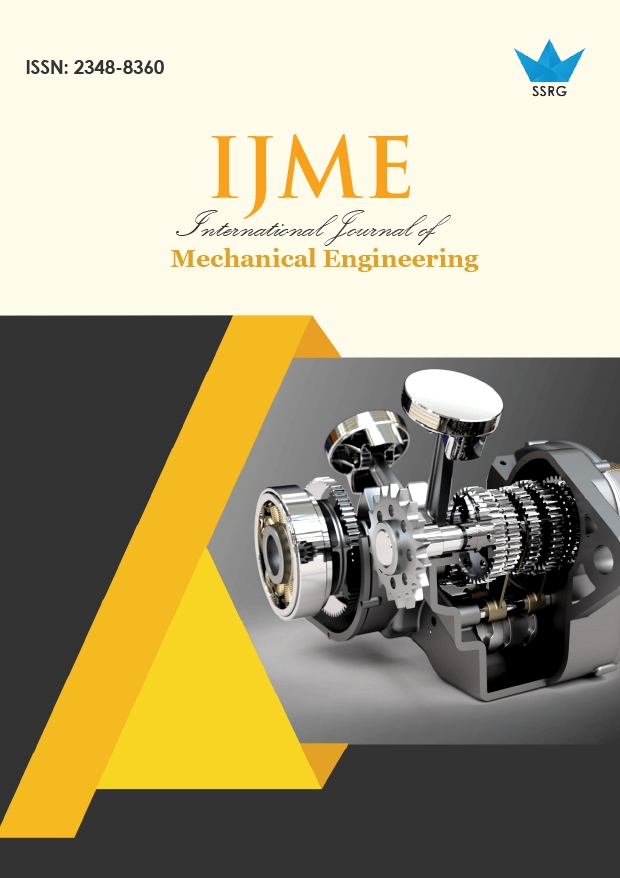Effect of Arc Welding Current on the Mechanical Properties of A36 Carbon Steel Weld Joints

| International Journal of Mechanical Engineering |
| © 2015 by SSRG - IJME Journal |
| Volume 2 Issue 9 |
| Year of Publication : 2015 |
| Authors : Asibeluo I.S, Emifoniye E |
How to Cite?
Asibeluo I.S, Emifoniye E, "Effect of Arc Welding Current on the Mechanical Properties of A36 Carbon Steel Weld Joints," SSRG International Journal of Mechanical Engineering, vol. 2, no. 9, pp. 32-40, 2015. Crossref, https://doi.org/10.14445/23488360/IJME-V2I9P113
Abstract:
This research work focuses on the effect of temperature as a function of current toward the mechanical properties of a welded joint of A36 carbon steel using Shielded Metal Arc Welding (SMAW). With the melting point of A36 steel at about 1426- 14700C, the range of the welding current was chosen from 70A -120A to give a varying amount of heat input. The hardness, impact and microstructure test were conducted to determine the mechanical properties of the welded joint. Increasing the current from 70A - 120A caused a corresponding increase in the temperature of the welded joint which affected the microstructure of the weld. The weld microstructure was controlled mainly by the cooling cycle. At 70A (i.e. with low level of current) the time for solidification was less. The rapid cooling promotes smaller grains. At 120A, the time required for solidification increases and therefore cooling rate slows down which yielded coarse grains. At 120A the grain size was most coarse with a hardness and toughness value of 60BHN and 11 Joules respectively indicating reduced strength and hardness.
Keywords:
At 120A the grain size was most coarse with a hardness and toughness value of 60BHN and 11 Joules respectively indicating reduced strength and hardness
References:
[1] Kalpakjian (2010): Manufacture Engineering and Technology. Prentice Hall, Singapore.
[2] Singh R.P, Gupta R.C and Sarkar S.C (2012): “The Effect of Process Parameters on Penetration of Shielded Metal Arc Welding under Magnetic Field usingArtificial Neutral Networks,” International Journal of Application or Innovation in Engineering and Management (IJAIEM), volume 1Issue 4.
[3] Renwick, B.G And Patchett M.M. (1976):“Operating Characteristics Of The Submerged Arc Process,” Welding Journal 55 (3). Pp 66 – 76.
[4] Huang C.A, Wang T.H, Han W.C, Lee C.H (2007): “A Study Of The Galvanic Corrosion Behavior Of Inconel 718 after Electron Beam Welding,” Journal of Material Chemistry and Physics.104:293 – 300.
[5] Jorge L. G. and Rodolfo L. M. (2012) : “Rietveld Quantitative Analysis Of Super Duplex Stainless Steel,” International Center For Diffraction Data, Department Of Metallurgical Engineering Universidad De Santiago De Chile, Casilla 10233, Santiago Chile.
[6] Kostrivas A. and Lipold J.C. (2008): ”Weldability Of Li- Bearing Aluminum Alloys”, Welding Journal. Pp 32.
[7] Schwemmer and Oslon(1979): Relationship Of Weld Penetration To The Welding Flux. Welding Research Supplement. Pp 153 – 160
[8] Gunaray V, Murugan N. (2002):”Prediction and Optimization (Part 2),” Welding Journal 79(10). Pp286 – 294.
[9] Malin V. (2001): “Root Weld Formation in Modified Refractory Flux, One Sided Welding (Part 2),” Welding Research Supplement. Pp227 – 229.
[10] Zhang X.P, Dorn L. (2006):”Correlation of The Micro Shear Toughness and Fracture Toughness For Pressure Vessel Steels and Structural Steels,” International Journals Of Pressure Vessels and Piping Joints. Pp. 445 – 450.
[11] Sarian S. and De Vadia L.A. (1999):”All Weld Metal Design For AWS E10018M, E11018M And E12018M Type Electrode,” Welding Research Supplement. Pp 217 – 219.
[12] Eroglu M, Aksoy M , Orhan N. (1999): “Effect of Coarse Initial Grain Size on Microstructure and Mechanical Properties of Weld Metal and HAZ of a Low Carbon Steel,” Material Science and Engineering, Volume 2, Pp.59 – 66
[13] Bhadeshia H.K.P.H (1997):“Model For The Elementary Mechanical Properties of Steel Welds” Institutes of Materials, London Pp 229 – 284
[14] Bracarense A.Q and Lui S. (1994):“Control of Covered Electrode Heating by Flux Ingredients Substitution” Welding & Metal Fabrication 62A. (5) Pp 18 – 32
[15] Gupta S.R. and Arora N. (1991): “Influence of Flux Basicity on Weld Bead Geometry and Heat Affected Zone in Submerged Arc Welding,” India Welding Journal 24(7) PP 27 – 133 [20]
[16] Charles H, and Entrekin J.R (1979): “The Influence of Flux Basicity on Weld Metal Microstructure,” Metallography 12:295-312
[17] Fleck, N.A Grong O, Edward G.R and Matlock O.K.( 1986): “The Role of Filler Metal Wire and Flux Composition in SMAW Transformation Kinetics,” Welding Journal, 65:113 - 114
[18] Smith N.J, Mc Grath J.T, GiaNetto J.A and ORR .F.(1989): Microstructure/Mechanical Property Relationships of Submerged Arc Welds In HSLA 80 Steel. Welding Research Supplement. Pp. 113 – 117.

 10.14445/23488360/IJME-V2I9P113
10.14445/23488360/IJME-V2I9P113